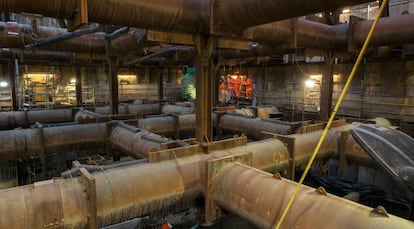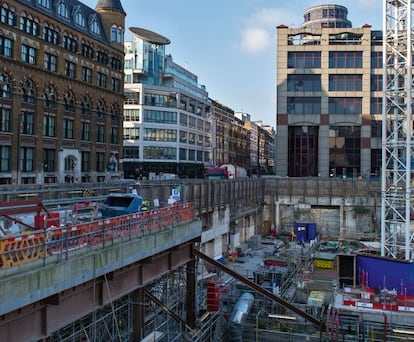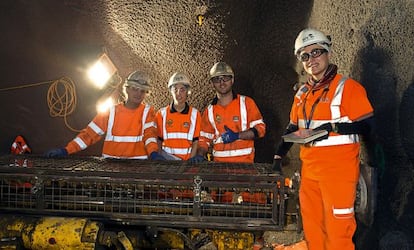A journey to the center of London’s new underground
The UK capital’s Crossrail project aims to solve the transport woes of a fast-expanding city One of the most complicated stretches has been awarded to Spanish engineers
Beneath the streets of London lies another world: a subterranean city as old as the one built on the surface. There are more tunnels under the Thames than under the river of any other capital. The secret, they say, is in the soil, and the clay on which the metropolis stands, while useless for agriculture, is ideal for drilling. And in the depths of this tunneled London, the history of the city itself can be read.
First it was the crypts, the Roman temples and the catacombs. Then came the sewers, the walkways, the bomb shelters, the gas ducts, the water pipes, the electricity cables. And reigning over this buried city, the London Underground: the oldest in the world. The network comprises 408 kilometers of active lines – along with a few that have been abandoned – which transport more than three million passengers every day.
The network comprises 408 kilometers of active lines, which transport more than three million passengers daily
As London grows, so does the city underneath it. The population of the British capital has just reached 8.6 million, surpassing the previous record total set in 1939, and is now headed toward 10 million – 250 new residents arrive every day. Today, a new artery is being added to London’s underground train system: Crossrail, the longest tunnel of all those excavated in the city throughout its history.
Around 200 million people a year will get on and off at the 40 stations lining the 21-kilometer east-west route, traveling on up to 24 trains that will run along it each hour. The aim of the two parallel tubes that make up the Crossrail line is to help solve the huge transport challenge the city faces.
The growth of London’s population is a sign of its economic strength, but demand for its limited housing stock has sent prices soaring, and people, as Mayor Boris Johnson said in January, “are being forced to live in places and suburbs that were never understood to be part of London.” The pressure on public transport is unsustainable: in the coming 35 years, the British capital will have to invest €652 billion to hold on to its position as one of the world’s leading cities, says the Conservative mayor. The plan includes six new bridges and tunnels over and under the river, a new airport, 200 kilometers of bike lanes, and the jewel in the crown, Crossrail, with a budget of €20.7 billion, to which will be added Crossrail 2, which will traverse London from north to south.

“We are now 30 meters under the ground,” explains Ferrovial Agroman’s project director Mariano de Andrés, one of a team of young Spanish engineers who have spent the last few years building this subterranean city. The Spanish company, part of a consortium with two other firms, is taking part in the Crossrail project, constructing two 6.4-kilometer tunnels and the new Farringdon Station.
Beneath this station, in the east of London, lies the heart of this gigantic project. Behind the fencing that barely captures the attention of the pedestrians heading to and from work is a vast hole that leads down to the construction site below. Farringdon, on the northern edge of the City of London, Europe’s financial center, represents the past and future of the London Underground. It was opened on January 10, 1863 as the terminus of the Metropolitan Railway, the first underground train route in the world. Today, three underground lines pass through here – the Circle, the Hammersmith & City, and the Metropolitan – as well as National Rail services.
At present, other stations have better connections, but Farringdon is set to become a crucial hub when the two biggest transport and infrastructure projects in the capital – Thameslink and Crossrail – cross it from north to south and from east to west. Both are scheduled to begin operations in 2018. The station will provide connections with three airports, with around 140 trains and 150,000 passengers an hour passing through it.

The hypnotic noise of the air circulating through the enormous ventilation tubes drowns out the sound of the city vibrating 30 meters above. Employees dressed in fluorescent orange overalls are at work along this immense, 6.4 meter-wide tunnel, through which, from 2018, will travel the 200-meter-long trains made up of 11 carriages carrying up to 1,500 people, double the amount that conventional underground trains can manage.
Engineers, geologists, biologists, surveyors: around 10,000 people have worked in these tunnels. People such as Alín Ron, a 28-year-old Spaniard from Asturias, whose job is to monitor any possible movement in the subsoil. The slightest shift, even of just a centimeter, could cause cracks in buildings up on the surface, she says.
“London is like Swiss cheese,” explains Mariano de Andrés. “We have had to make our way around 14 Underground lines in service. We have been underneath some very important places. Beneath Tottenham Court Road, we were just 70 centimeters from the Northern Line. The Massachusetts Institute of Technology took part in the surveys. A control system was set up to detect movement on the surface. If something moves, cement is injected. We have used a million liters.”
The eight tunneling machines are called Phyllis, Ada, Elizabeth, Victoria, Mary, Sophia, Jessica, and Ellie, all christened by Londoners who took part in a competition on the project’s website. Work could not begin until they were given a name: engineering also has its superstitions.
Around 200 million people a year will get on and off at the 40 stations lining the 21-kilometer east-west route
Each of them is 150 meters long, weighs 1,000 tons and can dig out 20 meters a day, employing enough force to lift 2,900 London taxi cabs. They drill and remove the earth at the same time, producing mountains of soil that has to be taken away. The 1.2 million tons removed along this stretch were taken to Wallasea Island, in Essex, helping to create a nature reserve with the help of the Royal Society for the Protection of Birds.
Installing and removing the gigantic, German-made excavators from under central London is no easy task. Four of them were sent to Farringdon, and two are set to stay, as it is easier than getting them back up to the surface. Here they will remain forever: relics of the hidden history of the city, like the 13 skeletons that a Crossrail digger uncovered in March 2013 under Farringdon Station, close to a monastery cemetery, which are believed to belong to victims of the Black Death, buried some time around 1349.
“You will find everything associated with an engineering project here,” says Mario Móstoles Nieto, director of Ferrovial Agroman in the UK and Ireland. This is Europe’s largest civil engineering project. And one of the most technically complicated stretches of the construction work has been awarded to Spanish engineers. “I have worked in five countries and I can say that in Spain we have the best-trained engineers,” says Móstoles. “A lot of projects were carried out in the space of 20 years and professionals learned very quickly. Our workers are the most qualified and many of them are working abroad. Public investment in Spain isn’t what it was and civil engineers have little choice but to go abroad. If we didn’t have something to offer, we wouldn’t be here. It makes them feel comfortable to know that Spaniards are on the job. We have experience and we make decisions quickly. We are considered an important player in this market.”

Ferrovial Agroman carried out its first job in Ireland in 2003 and from there made the move to the United Kingdom. Today it has a workforce of 400 people in a country that is now its most important market after Spain. Roads, airports, trains, municipal services: “We have grown organically here and through tendering processes, not by buying other companies,” says Móstoles. “In the United Kingdom, the main service suppliers are jointly owned by foreign companies, this is a country that is used to that kind of practice. We’re treated like locals here. And it is on very difficult projects like Crossrail where we provide added value.”
The first Ferrovial Agroman excavators began drilling here in 2012. Despite the enormous complexity of the project, work is moving according to schedule. Everything would indicate that by 2018 the first trains will be traveling through these tunnels. This will be a new milestone in the history of underground London, almost two centuries after French-born engineer Marc Isambard Brunel, father of the more famous Isambard Kingdom Brunel, invented a shield for drilling tunnels. The precursor of modern tunneling machines, it was used to dig under the Thames for the first time.
Brunel’s many schemes repeatedly ruined him, and he ended up in a debtors’ prison in Southwark in 1821. This was where he came up with an invention that would change the history of engineering, and with it, London itself. He had observed how woodworms drilled through wood, and decided to try to recreate the technique for civil engineering.
Freed after the government paid his debts, Brunel then began trying to convince investors to put their money into his project to drill a tunnel underneath the Thames. After a failed attempt at the beginning of the century, in February 1825, work began under his supervision of the first tunnel under the river. It would take him 16 years to finish the project, which was scarred by collapses, illness and death. Brunel’s diaries give some insight into the scale and dangers of the project that almost killed him. “The very walls were in a cold sweat,” wrote one journalist in The Times after attending the tunnel’s opening.
That tunnel was never used for carriages or pedestrians. But in 1869 it was acquired by the East London Railway, and is still in use today, connecting Wapping and Rotherhithe to the Underground.
Six years earlier, the Metropolitan Railway had opened, the first Underground line. But it was built using a different method: a stretch was dug out of the surface, the tunnel laid, and then the earth filled in. The image of steam trains disappearing into the ground captured the imagination of Victorian London. Reports from the time talk about an atmosphere “worthy of the opening of a great work of theater” at Farringdon Station on the day of the first trip.
Today, under the very same station, José Miguel Soto, Rubén Rodríguez, Paula Cabrero and Eneritz Otxoa, all from Spain, are assessing the consistency of the thin final layer of earth that separates the two Crossrail stretches. Everything has to be ready for when, in just a few days, the tunneling machine coming from the east will knock down the wall, and with it, the final barrier in this underground city.
Tu suscripción se está usando en otro dispositivo
¿Quieres añadir otro usuario a tu suscripción?
Si continúas leyendo en este dispositivo, no se podrá leer en el otro.
FlechaTu suscripción se está usando en otro dispositivo y solo puedes acceder a EL PAÍS desde un dispositivo a la vez.
Si quieres compartir tu cuenta, cambia tu suscripción a la modalidad Premium, así podrás añadir otro usuario. Cada uno accederá con su propia cuenta de email, lo que os permitirá personalizar vuestra experiencia en EL PAÍS.
¿Tienes una suscripción de empresa? Accede aquí para contratar más cuentas.
En el caso de no saber quién está usando tu cuenta, te recomendamos cambiar tu contraseña aquí.
Si decides continuar compartiendo tu cuenta, este mensaje se mostrará en tu dispositivo y en el de la otra persona que está usando tu cuenta de forma indefinida, afectando a tu experiencia de lectura. Puedes consultar aquí los términos y condiciones de la suscripción digital.
Últimas noticias
The complicated life of Francesca Albanese: A rising figure in Italy but barred from every bank by Trump’s sanctions
Half of Scotland is in the hands of 420 property owners
Pinochet’s victims grapple with José Antonio Kast’s rise in Chile
Reinhard Genzel, Nobel laureate in physics: ‘One-minute videos will never give you the truth’
Most viewed
- Pablo Escobar’s hippos: A serious environmental problem, 40 years on
- Why we lost the habit of sleeping in two segments and how that changed our sense of time
- Charles Dubouloz, mountaineering star, retires at 36 with a farewell tour inspired by Walter Bonatti
- Reinhard Genzel, Nobel laureate in physics: ‘One-minute videos will never give you the truth’
- The Florida Keys tourist paradise is besieged by immigration agents: ‘We’ve never seen anything like this’










































